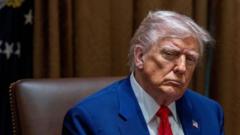In a bold move last week, President Donald Trump unveiled a sweeping tariff strategy designed to radically alter the global economic landscape and disrupt long-standing trade relations, particularly with allies. However, in a surprising turn, Trump has since placed a hold on escalating tariffs against most nations for 90 days while intensifying a trade conflict with China. As a result, the question arises: is Trump making any headway toward achieving his ambitious tariff-related objectives? This article evaluates five of his principal trade ambitions and their current status.
1) **Enhancing Trade Agreements**
Trump's perspective on trade is stark: the United States has been exploited by various nations, both friends and foes. His extensive tariff plan proposed a universal 10% tariff across the board, causing a ripple effect among global leaders, many of whom urgently sought negotiations to avert economic turmoil. The administration claims that over 75 world leaders have approached Trump for discussions. Although no listing of specific countries has been confirmed, negotiations are reportedly underway with South Korea and Japan. As the clock ticks down in this 90-day negotiation window, there are signs that cooperation may be achievable.
2) **Revitalizing American Manufacturing**
Trump has long posited that tariffs serve as a protective barrier for U.S. manufacturing against unfair competition from abroad. While the potential for increased production exists, genuine progress requires commitment and stability in trade regulations. Recent erratic tariff policies, however, raise uncertainty, leading companies to stall significant investments in domestic production until clearer guidelines emerge.
3) **Confronting China**
China has been positioned as the focal point of Trump's trade troubles, often described as the root cause of U.S. trade issues. Although he has softened his tone towards China, stating the blame lies with previous American administrations, there remains a substantial risk in engaging with the world's second-largest economy. The challenge lies in balancing this confrontation without alienating essential allies.
4) **Increasing Revenue**
Trump has also indicated that his tariffs would generate substantial revenue for the U.S. government, which could be channeled towards reducing the national debt and funding tax initiatives. Estimates suggest that a 10% universal tariff could yield around $2 trillion over the next decade. This revenue could offset costly tax cuts, raising critical questions about the long-term sustainability of such financial strategies.
5) **Lowering Prices for Consumers**
Despite promises that increased domestic production would ultimately lead to lower consumer costs, economic forecasts indicate the opposite. Analysts warn that the introduction of tariffs will likely increase prices on imports, disproportionately affecting low-income Americans. The initial benefits intended by Trump’s policies may be overshadowed by greater overall consumer costs.
As Trump navigates potential victories and setbacks in his tariff policies, the intricate balance between economic power, consumer welfare, and global diplomacy remains a pivotal landscape in his presidency. Observers will continue to monitor the unfolding dynamics that could either bolster or hinder his ambitions significantly.
1) **Enhancing Trade Agreements**
Trump's perspective on trade is stark: the United States has been exploited by various nations, both friends and foes. His extensive tariff plan proposed a universal 10% tariff across the board, causing a ripple effect among global leaders, many of whom urgently sought negotiations to avert economic turmoil. The administration claims that over 75 world leaders have approached Trump for discussions. Although no listing of specific countries has been confirmed, negotiations are reportedly underway with South Korea and Japan. As the clock ticks down in this 90-day negotiation window, there are signs that cooperation may be achievable.
2) **Revitalizing American Manufacturing**
Trump has long posited that tariffs serve as a protective barrier for U.S. manufacturing against unfair competition from abroad. While the potential for increased production exists, genuine progress requires commitment and stability in trade regulations. Recent erratic tariff policies, however, raise uncertainty, leading companies to stall significant investments in domestic production until clearer guidelines emerge.
3) **Confronting China**
China has been positioned as the focal point of Trump's trade troubles, often described as the root cause of U.S. trade issues. Although he has softened his tone towards China, stating the blame lies with previous American administrations, there remains a substantial risk in engaging with the world's second-largest economy. The challenge lies in balancing this confrontation without alienating essential allies.
4) **Increasing Revenue**
Trump has also indicated that his tariffs would generate substantial revenue for the U.S. government, which could be channeled towards reducing the national debt and funding tax initiatives. Estimates suggest that a 10% universal tariff could yield around $2 trillion over the next decade. This revenue could offset costly tax cuts, raising critical questions about the long-term sustainability of such financial strategies.
5) **Lowering Prices for Consumers**
Despite promises that increased domestic production would ultimately lead to lower consumer costs, economic forecasts indicate the opposite. Analysts warn that the introduction of tariffs will likely increase prices on imports, disproportionately affecting low-income Americans. The initial benefits intended by Trump’s policies may be overshadowed by greater overall consumer costs.
As Trump navigates potential victories and setbacks in his tariff policies, the intricate balance between economic power, consumer welfare, and global diplomacy remains a pivotal landscape in his presidency. Observers will continue to monitor the unfolding dynamics that could either bolster or hinder his ambitions significantly.




















